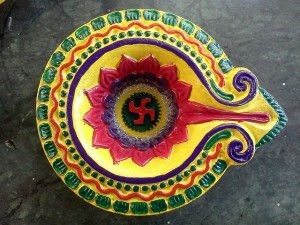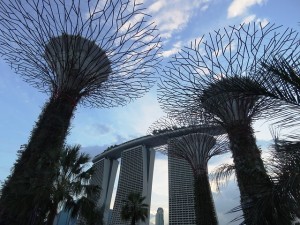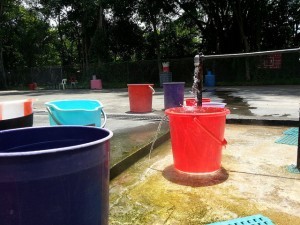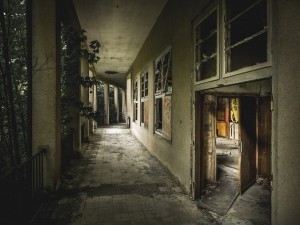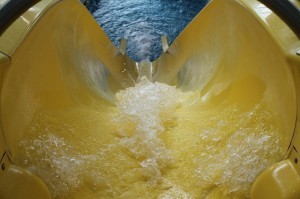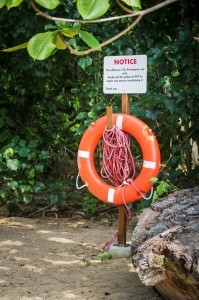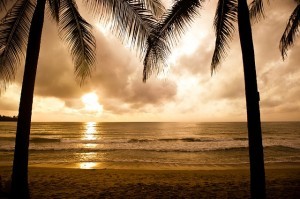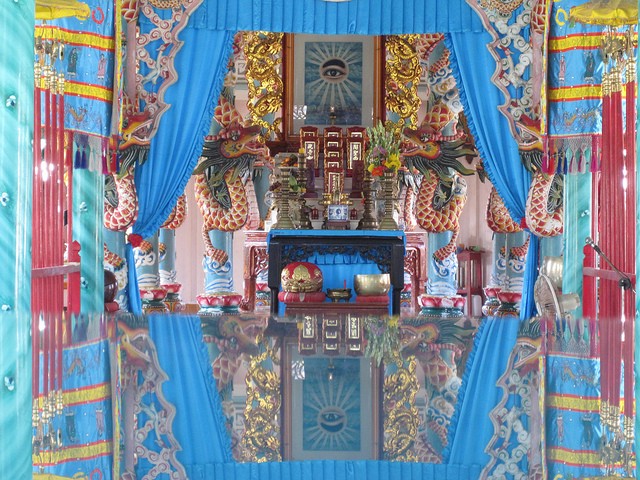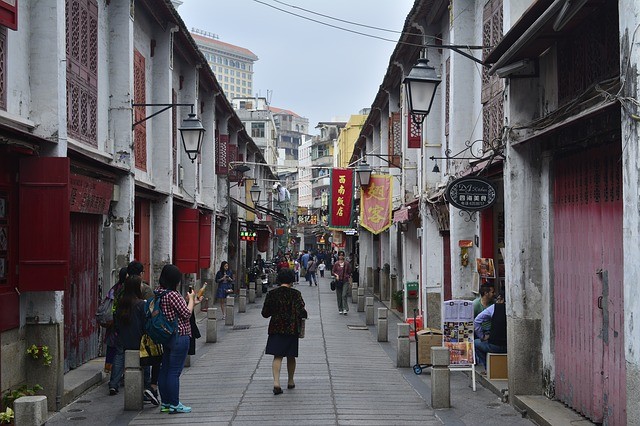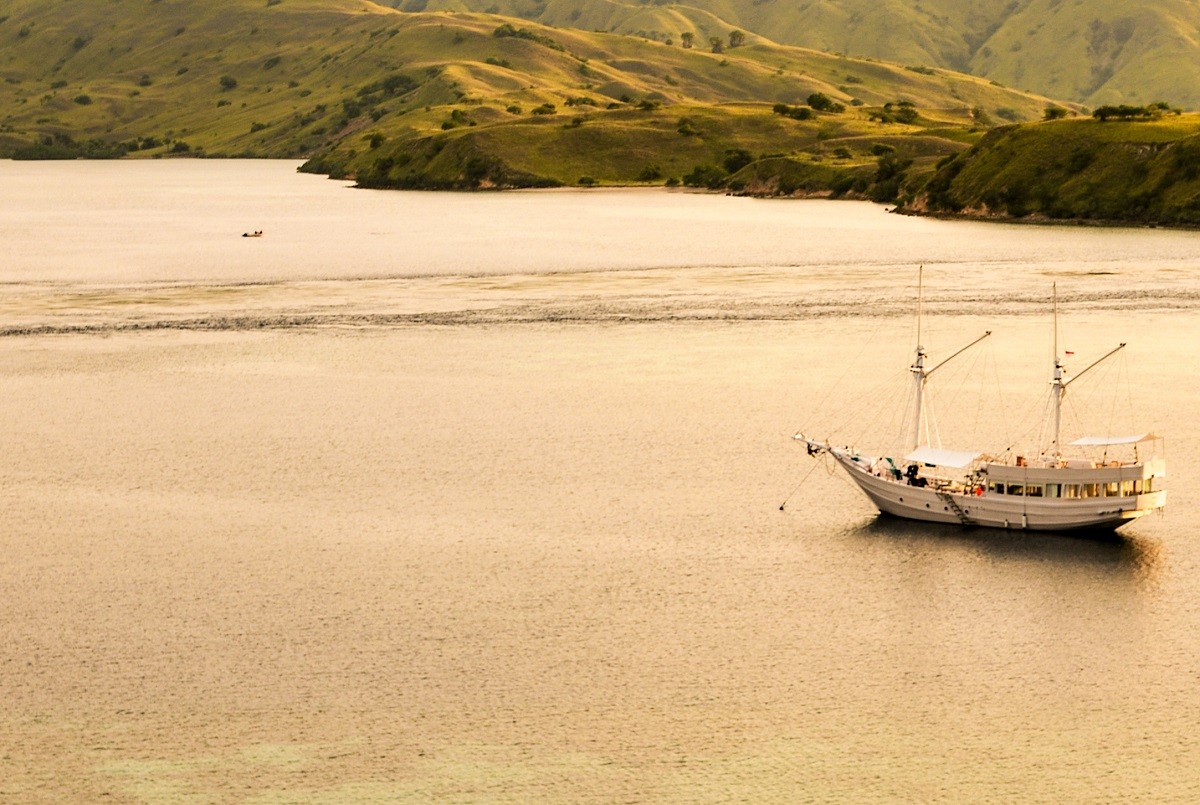Thanks to the huge Indian population in Singapore, there are numerous ways that you can celebrate the Festival of Light in the city. So if you want to celebrate this Indian tradition (it falls on 14th November this year), head on down to Little India and take part in some of the fun.
Enjoy the lights
Simply taking a walk along the streets of Little India is enough to see some beautiful displays of lights. The real focal point are the peacocks at the beginning of Serangoon Road, and if you want to see the lights at their best, hang around until 7pm when the sun goes down and the whole street becomes electrified. The lights will be on until midnight and will last for a little longer than the five days of the festival of light.
Enjoy some authentic Indian food
The Song Of India is offering a special menu for Diwali and you will be able to see why they have earned a Michelin star. The tasting menu has four courses, including an ‘art palette’ that has seven different tastings. If that is out of your budget, then head to any of the Indian restaurants that dot the streets in Little India for some deliciously authentic food.
Eat sweets until you feel sick
Indian sweets are addictive, sticky and sugary and once you start, you won’t be able to stop. Head over to Punjab Grill at Marina Bay Sands to buy their special Diwali sweet boxes. Look out for mango with white chocolate as well as green tea and pistachio. They also have plenty of dates and figs to celebrate without going into a sugar coma.
Singapore’s desire to be a city in a garden is no better exemplified than the spectacular Gardens By The Bay. It can be difficult to know where to start, so here is our quick guide to the best way to make sure you don't miss anything.
The gardens are divided into Bay Central Garden, Bay East Garden and Bay South Garden. Supertree Grove, the super-size man-made trees, are in the south garden. They are covered in trellises and are home to over 300 types of plants. Best seen at night, you can also take the Skyway, an aerial walkway that lets you walk among the canopies of the smaller supertrees. There is a particularly stunning light show, Rainforest Orchestra, which takes place at 7.45pm and 8.45pm.
In the south garden, you can also find The Cloud Forest and The Flower Dome. These work alongside the supertrees, and aim to project the vision of sustainability. Visiting the Cloud Forest means that you will come face to face with the Cloud Waterfall, which are over 35 metres high. Following the path, you can also see the different plant life found at different sea levels. The climate here replicated is that of Southeast Asia and South America, whereas the Flower Dome is more Mediterranean, as well as featuring the drier climates of Australia and South Africa. There is also a spectacular orchid display here, as well as flower arrangements which change with the seasons.
From here, head to the Heritage Gardens. This is a look at the diversity in Singapore, with Indian, Chinese and Malay gardens. There is also a water play area in the Far East Organization Children’s Garden, perfect for the humid summer months.
Where to find food on your walk
There are some food outlets at the Supertree Grove, but these are definitely catered to tourists. If you want something more local, head away from the Marina Bay Sands Hotel. You will eventually find Satay By The Bay, a fantastic hawker center with almost every type of food on offer.
You can arrive at the Gardens by taking the Circle and Downtown Lines, the nearest MRT station being Bayfront. The park is open from 5am- 2am and admission is free. Opening times and admissions for the conservatories and other attractions may vary. You can visit the website for more information.
Have you visited the Gardens by the Bay yet? What is the best attraction to see? Comment below with your experiences!
Why not treat yourself to a visit to one of Singapore's quaintest attractions? Find out all about this quirky little place below.
The history of the Sembawang hot spring
Found in 1903, this little spring was almost turned into a commercial venture. However, this fell through, mainly due to the fact that nobody knew where the water was coming from and if it was sustainable. However, more than 100 years later, the water is still running and is boiling hot! The spring was discovered by the son of Seah Liang Seah, the famous Chinese pioneer and namesake of many a steamboat buffet. A well was built by the spring, and it became popular with villagers who used the water for its healing powers. The spring became more and more famous, eventually attracting the attention of a soft drinks firm. They began to bottle the water but the flow was interrupted after being hit by a Japanese bomb during 1942. After conquering Singapore, the Japanese eventually began to build baths in the area. Interestingly, the spring was visited most frequently by gamblers, who took good luck baths before heading to the casino. Later, the Sembawang Air Base acquired the land but agreed to preserve the spring, due to its popularity.
How to get to Sembawang springs.
The spring is located on Gambas Avenue, between Sembawang and Yishun. Exit the Yishun MRT from exit C. If travelling by bus, take the 858 or 969 and get off 4 stops after exit C at Sembawang Road. Walk towards the overhead bridge and continue straight down the road. Take the left at the first junction where you can see the HDB Centre of Building Research. Keep going along the road until you see the two red signs. Enter through the gate and follow the path which will take you to the hot spring. The gate will only be open from 7.00 am to 7.00 pm daily.
The spring itself
The spring is locked inside a concrete structure but there is access to the hot water from a tap. Many people collect water in buckets and fill a paddling pool in order to enjoy the spring. Some people even take a shower directly from the taps, there are more than one tap, so don’t worry if some are already in use. The spring is visited by all ages looking to feel the benefits of its supposedly restorative properties for skin complaints such as eczema and conditions such as arthritis. If you ask the caretaker, he will provide you with a bucket and a towel to make your own foot bath. Some visitors even bring eggs to boil as a snack! Whilst the experience is not exactly like that of a first class spa, it is certainly much cheaper (free, in fact) and a lot more fun.
Have you ever visited the hot spring at Sembawang? Comment below with your experiences!
Kampong Lorong Buangkok remains untouched by Singapore’s rapid expansion. Visiting this village shows just how much the city has changed over the last few years, and it can be seen as the last surviving link to Singapore’s past. Here is the story of the last kampong of Singapore. The land was first acquired by Sng Teow Hoon, a Chinese medicine seller, who rented out the land for people to build homes. The land later passed to his children, one of whom still lives there in the kampong to this day. The families that live there pay a small sum of S$30 in rent.
The kampong
Coming from the Malay, kampong etymologizes the English word ‘compound’, symbolizing a group of small houses that live together in close quarters to form a community. Singapore had plenty of kampongs until they were unilaterally destroyed to form high-rises to cope with the rising population. The survival of Lorong Buangkok really has been against the odds, even considering that it now rests on a swamp. The kampong as it stands today is home to 30 families, a mix of Malay and Chinese. Modern life has not infiltrated the community so much, amazingly. Families all know one another and take part in activities together, displaying the best example of ‘kampong spirit’ where people live together and survive together, without petty fallouts and consternation.
Visiting the kampong
There is not an awful lot here, so you can take your time to walk the streets. Rural life here has been beautifully preserved, and visitors can see plant life all around, encompassing shops, houses and even the local mosque. Take your time to walk around, but remember to be respectful. This is not a museum, and people still live here so be careful not to peer into too many windows. The houses are situated on dirt paths and are made of wood with zinc roofs that are distinctly weathered. There are no gates or barriers protecting the homes and if there are gates, they will usually be open. A rare sight indeed in Singapore. This is another representation of the kampong spirit that exemplifies this community. You will be greeted by dusty fake flowers, abandoned TV sets, ancient postal code signs and wooden clogs lined up outside the door. This perfectly exemplifies the olde worlde feel of the kampong. There are rumours that the kampong’s days are numbered much like the Bukit Brown cemetery in order to make way for new high-rises, so visit now whilst you still have the chance to appreciate a more rustic style of life.
How to get there
Take buses 70 or 103 from Serangoon MRT and ride 10 stops down the line to Church of St Vincent de Paul. Cross the road and walk towards the Shell petrol station. There is a flight of stairs next to the petrol station, which you need to walk down, cross the canal and walk straight. The kampong can be found on the left.
Have you visited the last remaining kampong in Singapore? Comment below with your experiences!
If the tropical temperatures are getting you down and no amount of poolside relaxation and cold showers are doing the trick, then why not take a trip to visit some of the most haunted places in Singapore?
The Yellow Tower at East Coast Park
An extremely popular place to visit in summer, East Coast Park has a rather incongruous yellow tower. Apparently the tower was the scene of a particularly brutal gang-rape of a young woman as she strolled around the park with her boyfriend. She was later murdered and her boyfriend left unconscious after a savage beating. The criminals were never found. Years later, many people have seen a lone female figure wandering near the tower, as well as hearing screams for help. Several ghost hunting groups have tried to communicate with the woman and some have allegedly succeeded.
Old Changi Hospital
What is it about abandoned hospitals that allows us to feel so scared? The hospital was originally occupied by the British before passing into Japanese hands during the occupation period before finishing with Commonwealth forces and the Singapore Air Force. Thanks to its reputation as a Japanese torture chamber, screams and shadows can be seen all over the hospital.
Brunei Hostel
Abandoned for 25 years, this hostel is the go-to for those looking for a paranormal encounter. The hostel was originally built to house students from Brunei who were in Singapore on a foreign study programme, before returning to their home country as qualified teachers. Nothing particularly gruesome happened here, but the building’s desolation has meant that many have heard strange noises and felt maleficent presences nearby.
Wild Wild Wet
This is an especially good idea if you are travelling with children. They have built four new rides since October 2017 and this water park is a great day out for little and big kids alike. From the Kraken (a four lane mat slide) to the Torpedo, where you are ejected from a capsule eighteen meters in the air into a freefall, there is plenty to do for those who prefer to cool off in the water. They also have more gentle slides like the Royal Flush, Slide Up and Ular-Iah, which allows families to ride together. They even have rest zones where you can lie back and suntan. For little kids, there is a toddler’s play zone as well as a pool for babies. They have plenty of facilities for young families, such as nursing rooms, kid’s shower cubicles, baby carriers and even baby floats. A great choice for the whole family!
Go ice-skating
Whilst this sport may usually be reserved for winter months, it is also a great chance to cool off whilst enjoying a new sport. Thanks to it’s indoor location, you can also enjoy the air-conditioning! JCube Shopping Mall has a rink which also offers classes in figure skating, ice hockey, curling and speed skating.
Escape Rooms
Increasingly popular, and with plenty of options all over Singapore, these are a great indoor activity that means you escape the heat of the street. If physical exercise is not your bag, then some mental exercise might just do the trick instead. This is a great activity if you have a group of friends willing to take part, and it can be a lot of fun. Many escape rooms have different themes, such as solving crime or escaping from zombies. You can even try to escape from Aokigahara, Japan’s notorious suicide forest, or Alcatraz. Lost SG, Escape Artist, Lockdown, Escape Hunt and Trapped SG are some of the best.
Travelling to far-flung destinations can be exciting or daunting, depending on your frame of mind. But one thing is for sure, taking a little time to plan can make all the difference once the novelty wears off and the boredom sets in...
First of all, what a long-haul flight is requires some definition; technically, it is any flight that is over four hours, however, just to add to matters, it then falls into two different categories; medium long haul and ultra-long haul, the latter being a flight over eight hours. For example, a flight from London to Hong Kong totals around twelve hours making it ultra-long-haul. But it is not just the length of the actual flight that needs to be planned for, there is the journey to the airport, check in, security, boarding, immigration checks at your destination, reclaiming baggage and then your transfer to your final destination all adding hours to your total door to door time. We’ve put together some of our best tips to help you survive your long-haul trip!
Be kind to yourself. Reducing your stress levels the day before your trip can make a huge difference to your experience on the big day. Make sure you plan ahead and get everything ready in plenty of time to avoid those last-minute panics that stress everybody out; make sure you have located and checked all your documents in good time, why not treat yourself to a nice folder to keep your tickets, passports, visa information, insurance, emergency contact numbers, your travel itinerary and other relevant articles in. Then the day before you travel you will be able to do pleasant activities that relax you; don’t pull a 12-hour shift and leave your packing until the small hours of the morning.
Hand luggage and essentials ‘flight pack’.
Well thought out hand luggage can be a real gamechanger on a long-haul flight. Having the right items within easy reach can reduce stress and add to your comfort. Make sure you pack some extra layers of clothes to wear; cabin climate control can sometimes be on the chilly side and having spare clothes, or at least fresh underwear, to change into when you arrive will help you feel less dishevelled. Packing a little bag with essentials such as, comfort eye drops, toothbrush and toothpaste, tissues, flight stockings, painkillers, ear plugs, an eye mask, a small mirror, some make up, small pack of ‘freshen up’ wipes, hand cream, and antibacterial hand gel can go a long way to make your journey more comfortable, just pop it on top and everything will be within easy reach. Don’t forget to pack headphones, your phone, iPad or android tablet, (even in ‘flight mode’ these can help while away the hours). Don’t forget to install apps such as FlightAware which gives you updates on airport delays and flight delays, it can be set to send you notifications, weather updates, and maps your journey so you can see the route you will be taking. Being able to reduce boredom, stress, and anxiety is really useful, try using apps that use meditation techniques such as Calm, The Mindfulness App, Headspace, and Omvana are particularly useful when you're trying to sleep but find yourself distracted by noise, other people, or just the general goings on, alternatively, listen to music on Spotify, Google Play Music, or Apple Music apps to dull the drone of the plane engines. Downloading the kindle app on your phone or tablet means you can have a wide choice of reading material without adding bulk, or weight, to your hand luggage. Always download a few movies that you love because sometimes you just want to be brain dead and not have to follow a plot that requires any concentration, the movies may not be to your taste, and airplane screens can dry your eyes (hence the comfort eye drops in your essentials pack).
With steamy heat and the sun beating down, Singapore is the perfect place to enjoy some downtime by the side of a swimming pool. Now that the summer holidays are around the corner, what better excuse to take the family to one of the many complexes that Singapore boasts? Entry usually costs between 80 cents and S$3, and many have slides and water play. Here are some of the best in the city.
Jurong East Swimming Complex
This one is the largest in Singapore and it also has the best slides of all. There are three intertwined spiral slides as well as a wave pool with music. If you really want to cool off, try to stay near the rock caverns as they routinely spray water to resemble a storm. The complex offers plenty of shade and even jets to cool you down if it starts to feel too much. Tickets for a family of four are S$10 and remember to take spare change to use the lockers. Many of the rides are signposted with signs encouraging children to eat healthily and feature the calorie count of some of the nation’s best dishes. Some might be better not to look at! Jurong East Swimming Complex, 21 Jurong East Street 31.
Our Tampines Hub
Our Tampines Hub has recently been upgraded and offers a stunning rooftop pool, where the views over the city are unparalleled. They have six pools in total so you don’t have to worry about fighting for space, plus for those who want to relax, there is a jacuzzi. The children’s pool is garden-themed and has water fountatins, water guns and a mini waterfall. For those who are a little more serious about swimming, there is a huge eight lane training pool which is big enough to sail in. Our Tampines Hub, Level 6, 1 Tampines Walk
Splash @ Kidz Amaze
This is the first indoor water playground in Singapore and is specially geared towards kiddies. It is slightly pricier than the others and a family of four can cost S$28 for members. Expect to pay S$40 for non-members. You really get your money’s worth as you can play for hours here. There are multiple play zones, five water slides and an Enchanted Deep Sea. They also host kid’s birthday parties, for all ages. 9 Sentul Crescent, Punggol
Sengkang Swimming Complex
Another popular choice this swimming centre has plenty to entertain children of all ages. There are some huge water slides and even ones specially designed for little kids. Best of all, they have a huge bucket of water where you can drench your kids, or vice versa. For families with older children, there is a jacuzzi where you can relax away from all the noise. Sengkang Swimming Complex, 57 Anchorvale Road
Choa Chu Kang Swimming Complex
This complex is enormous and it has some great features, such as a lazy river where you can sail in a boat. Their wave pool is also great fun and there is a specially designed water playground for toddlers. One of the more economic options, the complex is a great option for families who want to have fun and enjoy the summer sunshine. Choa Chu Kang Swimming Complex, 1 Choa Chu Kang Street 53
Where do you like to take the family to swim? Comment below with your recommendations!
You might have lived in Singapore for a while and think that you know all there is to know about the city. You might assume that amidst the skyscrapers and luxe hotels, there isn’t a square metre that lies undiscovered. Maybe not, but there are parts of Singapore that do not have quite the same footfall as others. These secret corners have some tantalising delights for tourists, expats, and locals alike. Let’s take a closer look.
Colbar
This bar used to be a British Army hangout back in the 1950’s and it has retained some colonial charm. They sell plenty of beer (British nonetheless) and Hainanese Chinese cuisine, including a great Hainanese chicken rice. There are plenty of historical artefacts, and the owners have tried to keep as true to the original as possible. Look out for the antique weighing machines.
Coney Island
Much like it’s namesake in New York, Coney Island is quite popular among locals and tourists alike. There are also plenty of white beaches, that look as if they could be straight out of a Thai holiday brochure. Punggol Ranch is the entrance point, and it is worth looking at itself, for all the flora and fauna on display. Some plant species are even believed to be extinct throughout the rest of Singapore. You might even be lucky and catch some birds in migration.
Bollywood Veggies
This organic farm, run by Ivy Singh Lim, is out of the main drag of the city but is well worth the car trip. There is an excellent restaurant here, which really does farm to table exactly right. The restaurant is not the only gem here. There are also plenty of workshops, kids activities, cooking classes and tours of the grounds.
Thailand is not all full moon parties, backpackers and island hopping. There are plenty of places for a family to don their swimming costumes and relax on golden sands. Since you might be thinking about where to go for your next family vacation, we have compiled a list of the best kid friendly beaches in Thailand.
Phuket
It might sound obvious or nothing special, but Phuket is actually a great place to take kids. There are a multitude of resorts, where you will find creches, kids clubs and plenty of light-hearted entertainment. There are also great beaches that remain popular with tourists. If your family enjoy watersports, then you will be able to find packages catering to your needs. Snorkeling is particularly excellent around Phuket, but you can also try diving, kayaking and boat rides. For the first time traveller, it might be a wise idea to stay in Phuket before exploring the other islands close by. Many are only a short boat trip away, so you will never be far paradise. Remember to do your research before you go, however. There are plenty of places in Phuket that are not safe for children.
Krabi
The coastal town of Krabi is becoming quite the tourist destination. Popular with backpackers for quite some time, it is also geared towards families with plenty of activities to do. It also goes without saying that Krabi has one of the most beautiful backdrops in Thailand. Thanks to its location, Krabi has plenty of options for diving, snorkeling, as well as kayaking to see prehistoric cave art in the caves around Krabi. The best beaches are Railay and Ao Nang, although you are only a stone’s throw from the Phi Phi islands. Krabi is becoming increasingly popular so try to visit before peak season, if at all possible to avoid the crowds.
Koh Samui
Despite being probably the most popular place to visit in Thailand, Koh Samui still has plenty of charm and much to offer for families. Beaches are never in short supply, but there are also jungles and hills to explore inland. In order to do this, you might want to rent a car or hire a guide. Koh Samui has some glorious waterfalls and natural swimming pools, as well as Ang Thong Marine Park. Whilst sounding like a Mediterranean theme park, it is actually a series of islands that have excellent opportunities for diving and snorkeling.
Ko Lanta
Ko Lanta is a wonderful place to visit with children. Klaong Dao beach is the best on the island by far for little ones, as the water is shallow and the waves are gentle. There are also rock pools in the rock formations around the edge of the beach, which make great exploring opportunities. Moreover, Ko Lanta has quite the concentration of child-friendly bars and restaurants. Many of them even offer toys for the kids to play with, whilst you enjoy a cocktail and watch the sun set.
Koh Chang
Koh Chang has been popular with young families and honeymooners for quite some time, and the popularity of White Sands beach for young families has been a closely guarded secret. The beaches here are clean, calm, and without any bars pumping out music 24/7. There are also plenty of family friendly restaurants on the island that serve food better suited to tiny taste buds. As in Ko Lanta, the water is warm, shallow and the waves are small, so perfectly safe for little ones.Which is your favourite family-friendly place in Thailand? Comment below!
Vietnam and Cambodia have shaken off their past and are now emerging as two of the hot holiday destinations of the East. Apart from bustling cities, great people, and delicious food, there are many temples that give you an insight into the history and culture of these two countries. Here is a list of the best!
Tran Quoc Pagoda, Vietnam
This is the oldest in Hanoi and is a perfect example of Buddhism in Vietnam. The temple has eleven levels, and a beautiful courtyard where you can burn incense. There is also a museum of relics related to the temple. Tran Quoc is also one of the temples of Vietnam that displays stunning carved statues. These are from the 17th century and each one is unique. The river surrounding the temple is also incredibly peaceful. This temple is one of the most famous temples in Vietnam for it’s status among the elite and show it shows it’s royal privilege.Cao Dai, Vietnam
This temple is located outside of Ho Chi Minh and boasts vibrant colours and festivity. It is slightly more modern than its counterparts, being built in the 1930’s. This temple is also not one of the Buddhist temples most commonly found in Vietnam, it is Cao Dai, which is a combination of Hinduism, Judaism, Buddhism, Taoism, Confucianism, Christianity, Islam and Zoroastrianism. If this leaves you a little confused, you can always watch a ceremony taking in the traditional dress. If you would like to become a little more familiar with the ways of Vietnamese culture, a visit to this temple is a must.Temple of Literature
This is one of the most famous temples in Vietnam, located in Hanoi. The temple is also from the 11th century and features a much more typical style of architecture. The gardens, pavilions, passageways and lake all combine to make this temple a place of tranquility. It is most commonly associated with university graduates from Hanoi and symbolises their path of academic achievement. The temple itself was built in honor of Confucius, and it is a monument to Vietnamese architecture and religion.Jade Emperor Pagoda
As well as being one of the most picturesque temples in Vietnam, this is also one of the most important. Located in Ho Chi Minh City, and built in the 20th century, it features heavy influence from China. This is due to the fact that the temple was built by Cantonese immigrants, who decided to construct a site for their worship. You can smell burning incense, as well perfumed flowers, which have been made in offering. Interestingly, the main hall of the pagoda has a very realistic portrayal of the God of Hell. There are also carvings of purgatory and the ten different levels of hell. Visitors also come here to make offerings to the fertility goddess Kim Hua, where you can see delightful representations of dancing children. Before leaving, make sure to feed the turtles who live in a large pond in front of the temple.Angkor Wat, Cambodia
It makes perfect sense that Angkor Wat features on a list of the most beautiful temples in the world, let alone in Cambodia. This is actually the largest religious monument in the world and was originally a Hindu place of worship before it’s conversion to Buddhism. What makes the temple so incredibly unique is that you are guaranteed to never see the same thing twice. Each carving is individual and equally impressive. There are several smaller temples that are in Siem Reap, Angkor Wat is the most famous, however, all the temples feature excellent examples of religious life in Cambodia.Koh Ker
This temple is notoriously difficult to access, and requires a full day of travelling from Siem Reap. The road to Koh Ker is brand new and extremely safe and the temple marks the spot of the Khmer capital during the 10th century which has now been made open to the public after being abandoned. The most intriguing part of visiting Koh Ker is that the temple has been overrun by plants and wildlife. Some argue this only adds to its mystery and spirituality. Prasat Thom is the most famous of the temples there, as it is effectively a giant pyramid with a mythical bird-man at the top.Preah Vihear
This is one of the most stunning temples in Cambodia for its location alone. It stands on a cliff close to a mountain range and the view is spectacular. The temples themselves all have their own courtyards and architecture. Again, all of these are entirely unique. The backdrop is marvellous as you are offered a view over the Cambodian landscape which is unparalleled anywhere else. The air of mystery in Preah Vihear is compounded by its isolation and it is well worth the effort to visit.Have you visited any of these temples? Are there more you would add to the list? Please comment below!
[caption id="attachment_3821" align="alignright" width="640"] Temples
Deciding between local and international schools for your child is one of the most pressing dilemmas an expat parent can have. The logical choice may be to send your child to an international school, where the chances are they feel much more ‘at home’. But are there some benefits to local schools that an international school simply doesn’t have? Lets take a closer look.
What works for your situation
As we discussed previously in our post about choosing the best international school, the first point to consider is what works for your child. However, equally important is what works for your familial situation. If you have relocated to Singapore based on the expat package your company has offered, then perhaps an international school is included in that. If it is not or if your situation changes, then perhaps you are left with no alternative but to take a look at the local system. It goes without saying that international schools are hugely expensive and it may be out of your budget to send your child there.
What works for your child
There is a stigma in Singapore that the local system is extremely rigid and traditional and there is little to offer by means of Learning Support. Whilst this may differ from school to school, the general consensus is that international schools offer far more in terms of hands-on support. If your child has different learning needs or will require support in the future, it is best to try to get an expert opinion. This can be from fellow parents, medical professionals or from talking to the school directly. What they can offer you does not depend largely on whether the school is international or local, but what their resources are.
Age matters
The age of your child will also ensure that your decision is swayed one way or another. If your child is kindergarten or pre-school age, many parents agree that the expense to send them to an international school is simply not worth it. The learning system at this age is largely universal between international and local schools, and it may well be that your local kindergarten has much to offer. If your child is older and preparing for exams, then again, the individual schools you have in mind must be consulted. Many parents veer at this point from reconsidering the local system and investing their time and cash in an international school. This depends on the type of exam your child is studying for. If it is baccalaureate or iGCSE, then your choices may be more limited.
Availability
It is not easy for an expat parent to admit their child into the local system. Many parents have expressed concern over the fight they have had to ensure their child a place. However, it is not impossible. But be prepared to have to work long and hard to ensure a place. This may also depend on the school and the type of visa that you have. If you are a long-term resident, it should be slightly easier than if you are not. Of course, it goes without saying that the only restriction on entering international schools aside from availability, is money. Research your options well and take a look at waiting lists to see how long a child typically has to wait for.
Macau has long been criticised as being the Las Vegas of the East, tacky and more than a little seedy. However, its proximity to Hong Kong means that it should not be discarded as a day trip or mini break option. Let’s take a closer look at what there is to do in the Eastern City of Sin.
Senado Square
Aside from the glitz of casinos, Senado Square is where both locals and tourists gather. This is where many argue the more genuine side of Macau lies. The shops are geared to tourists, but try to retain some of the island’s culture. There are also countless places to try street food, and the cafes that have stood in the same site for many years are the perfect place to start the day. After having breakfast here, you can walk off the haze of the morning by shopping or merely people watching. The streets around Senado Square are a little crowded at times, and often confusingly maze-like, but it is worth making the time to get a little lost.
The Ruins of St. Paul
Right in Senado Square is Macau’s most famous historical site. The stairs leading up from the square are full of tourists and but provide quite a unique view. It might be a little frustrating to dodge the tourists, but try to take it in your stride and enjoy a slice of local history. Mount Fortress can also be accessed easily from here if you want to learn a little more about Macau’s past. The battlements have lots of military artefacts and offers a bird’s eye view over the centre of the city. It is quite easy to forget the colonial past of Macau when confronted with modern casinos and a pulsing nightlife, but it is there and it can be enlightening.
For anyone, learning a second language is not easy. For children, learning a language can be facilitated not only in school, but also at home. Being surrounded by native speakers and native culture helps immensely, but there are some tips and tricks to help the process along. Here are some helpful pointers to help your child pick up their second (or more) language.
Organise a play date with a native speaker
This does not always have to mean joining a playgroup with local children, although that is certainly a good idea. Something as simple as introducing your child to colleagues who speak the lingo may start to prove useful. There may be meet-up groups in your area of other mothers who want to introduce their children to others and this is the perfect opportunity for your child to be exposed to the language. Try organising play dates if you know a child who speaks the language fluently. If the school or nursery offers classes after school hours, it might be a good idea to sign your child up for those. Most schools offer this kind of programme nowadays, particularly if there is a high concentration of expats in the community. Meetup.com is a great place to start, as well as checking local listings. If no group exists in your area, why not set one up yourself? It might be a great opportunity to meet other parents as well as practicing the language skills yourself!
Technology and your child
Technology is a gift when it comes to education, some may argue. Others may state differently but it certainly helps if it is difficult tracking down native speakers. There a million apps online nowadays to help your child, some more educational than others. Duolingo is popular with adults and kids alike, as it aims to make learning fun and bitesize. Using videos is always a good option, particularly if your child does not have access to their own phone or computer. YouTube alway has songs, dances and short lessons to help your child become accustomed to native speakers. As your child gets older, it may be worth investing in a programme such as Rosetta Stone . You could even try watching television together as a family in the other language to try and grasp the different intonations and sounds. Images work great with language learning, especially for children who are much likely to retain the color, shape and movement.
Team effort
It goes without saying that the more time you dedicate to your child’s language learning as a parent, the easier it will become. If you speak the local language well yourself, this will make you a great teacher and example to follow. If not, it can become a fun way to learn together. Playing games, such as Pictogram, is a great way to learn new vocabulary. Perhaps you can even try reading a book together, depending on the age of your child. As you grow more familiar with the language, going to the movies could be a great way of assimilating to both culture and language. Keep it simple however, otherwise you could all be at risk of getting frustrated!
Practice the language!
The key for language learning is to keep practicing. Depending on the age of your child, this could mean giving them greater responsibility in helping you shop for groceries, buying clothes or ordering in a restaurant. The more a child practices a language, the better equipped they will be at applying it in the real world. It is one thing to learn a language through study but quite another to speak outside the classroom. This way, your child can grow in confidence and fluency, whilst becoming more comfortable with their surroundings. A reward system is also worth considering as a way to compliment your child’s use of the language. If they do really well in class or speaking to a waiter, then treating your child may reinforce positive learning. Either way, plenty of praise is always appreciated when you are encouraging your child with something difficult. Patience is also key. We are all bound to make mistakes, so remember that learning a new language does not have to be perfect and it will take some time. Keep goals small and be prepared for plenty of frustration. With a bit of hard work and effort on all sides, your child will soon be able to speak freely in another language and that is really priceless.How did you help your child learn a language? What other tips did you listen to? Comment below with your ideas!
Travelling can be a meaningful, enjoyable and memorable experience for all the right reasons. Yet sometimes it is possible that we start to feel a little under the weather. It can be hard to stay healthy when relocating to another country as there are so many other preoccupations. Multiply that with travelling and suddenly, you find yourself bed-ridden. However, there are some preventative measures you can take and here is a list of our top ten tricks to stay healthy whilst on the road.
Hygiene first
It may sound obvious but when we are in the middle of a full bout of wanderlust, we often forget certain protocol that we would never abandon in ‘real life’. That means staying away from street food that may look tempting but does not practice effective hygiene. This advice does not mean you have to miss out on trying some local delicacies but exercise caution and common sense. It also goes without saying that washing your hands should take priority. If there are no facilities available, buy some antibacterial hand gel as a safety net. It also makes sense to wash your hands after using public transport as it can be a hotbed for germs.
Watch your water
Again, it sounds like common sense but it is wise not to drink anything that has not been purified. In slightly more upscale restaurants, there should be no need to worry but when you are on the road, it is best to only drink out of a bottle or can. It is also a good idea to leave out the ice, no matter how hot it is. It might seem refreshing at the time but you could regret it later. Watch out for beer bottles that arrive already opened too. The beauty of travelling around Asia is trying exotic fruits and juices but again keep an eye out for the water supply. It might be handy to have a bottle of water on hand to rinse off the fruit and try to steer clear of vendors who have ice from an unknown source.
Eat wisely
Nobody knows your body better than you do, so if spicy food is likely to give you a stomach ache, it might be a good idea to steer clear. When you are first adjusting to a new climate or atmosphere, try to keep it simple. Sticking to rice and plain foods for the first couple of days might sound boring, but it means that your digestive system quickly gets used to new flavors and cooking styles. Obviously, the better cooked the food, the less likely you are to get sick. Also make sure to keep an eye out for any potential allergens in food. This may not be that obvious but if you have a coconut allergy and your food is cooked in coconut oil, you may well have a problem. If in doubt, try to find another option or ask what ingredients have been used. Dairy products are uncommon in Asia but if you find anything with dairy in it, check to see if the product has been refrigerated. If not, you might want to think again.Try out vegetarianism for a day or two
As well as being allegedly healthier, sticking to vegetables for a few days may be a good idea whilst you are acclimatising. This does not mean you have to avoid meat entirely but if you are unsure, there are plenty of other options which still enable you to enjoy food on the go. Vegetables are far less likely to give you an upset stomach, as well as giving you an energy boost if your immune system has taken a hammering. Asian dishes usually have an array of fresh vegetables in them, and all of them are delicious. Served with rice and some spicy sauce, you can have a great meal without any of the worry that you are going to spend the next day feeling green around the gills.
Be prepared
A lot of people swear by probiotic supplements or herbal remedies to alleviate any symptoms before or as they happen. Carrying a supply of chamomile tea is often the salvation your stomach needs after a dodgy dish. Acidophilus pills are also quite common in helping to adjust our stomachs to new foods. Whether this may work for you or not is a question of testing it out, but it might be worth considering as you prepare for your trip. Certainly, having some anti-diarrhea pills and pain killers may be wise if you do find yourself caught out. Prevention is often better than cure, so speak to your pharmacist before travelling to see if they have any recommendations.
Do you have any tricks for staying healthy on the road? Comment with your suggestions below!
Are you an expat looking to make the most out of your stay in Southeast Asia? How about a romantic diving trip for two on a sailing boat? Our latest guest blogger and author of We Love It Wild, Nanda Haensel, comes onboard TheExpat.com to share her unique experience of sailing to Komodo Island, Indonesia, aboard the Alexa for three days! Team Expat believes this is an experience that you cannot miss once you're more or less settled in the neighboring region.
Sailing on a boat isn't as easy as it seems, given that most people are prone to motion sickness and there is a decided lack of amenities onboard. However, it’s an experience that adventurous expats should try given that the climate in Southeast Asia is ideal for sailing (not too hot, not too cold), plus it cuts down on a lot of travelling time if you’re flying from Singapore, Kuala Lumpur or Hong Kong to Indonesia.
But enough raving on our part, hear it from Nanda herself, first hand. Makes you want to book a boat, leave work behind and just sail away...
Setting sail on the Alexa
It was on the late evening of 17 April when the 4 of us caught a flight on the Singapore Airlines from Singapore to Bali. As we can’t fly directly to our destination, we had to take a connecting flight to Labuan Bajo, which we had scheduled early next morning. Located at the westernmost tip of Flores, the town of Labuan Bajo is a small fishing village that marks the starting point of tourist trips to Komodo Island. There, we first laid eyes on our stunning sailing boat, the Alexa.A former cargo boat, the Alexa was transformed into the most romantic sailing boat in Indonesia with the bones of an original phinisi. Described as “a single-cabin vessel in Indonesia built for a love affair”, we immediately fell in love with its beautiful simplicity, despite the fact that we were not exactly looking for a sailing boat, as we were travelling with 2 more friends. As the boat was only built for 2, it has only one bedroom for 2, but my husband and I decided that we wanted to sleep in the open on the upper deck, under the blanket of stars, instead, so the arrangement worked out fine.
A brief history of Komodo Island
So why did we choose to sail to the Komodo National Park? When we’ve heard that the diving experience in Komodo is world-class, the opportunity seemed too good to pass up.Komodo is unique in that it offers 2 completely different marine environments with over 1,000 species of fish faunas. Komodo National Park is located between the islands of Sumbawa and Flores in the Lesser Sunda Islands, at a distance of 200 nautical miles to the east of Bali. It includes three major islands: Komodo, Rinca and Padar, as well as numerous smaller islands. Combined, they boast a total surface area of more than 1,800 km.
The park has been identified by WWF and Conservation International as a global conservation priority area, and declared a World Heritage Site by UNESCO. With such a rich marine biodiversity, diving in Komodo should be on the to-do list for anyone who is passionate about marine life and the sea.
Dive, dive, diving!
We started our dive safari at Siaba Besar, which is an amazing dive site in north Komodo. A beautiful coral garden lies along the western coast of the island with the currents getting stronger the farther south you go. During our dive, we were lucky enough to spot black tip sharks, barracudas, snappers, trevallies, wrasses and turtles!Our next dive site was at Pink Beach, one of the seven pink beaches in the world. The “pink” sand is a result of the white sand mixing with the red coral in the shallow waters, and is another one of the many amazing features of Komodo.
The highlight of the trip, however, was the following day. The morning dive happened at Manta Point, which is well known as the spot where large groups of manta rays. As a result, it’s also a popular diving site—or it’s supposed to be, for we never saw anyone else there. Our diving instructor, Michael, and the 4 of us were the only ones swimming with 15 giant manta rays. At least, that’s what we were trying to do, for the currents were very strong here, and avoiding getting ourselves dashed on the rocks was more of our priority.
After Manta Point, we headed to our final dive site, feeling overwhelmed. Thankfully, our diving experience in Golden Passage was less crazy. We managed to do drift diving here, which is a type of scuba diving where the diver is transported by the currents caused by the tide, giving you the impression of flying. The coral reef was easily the most beautiful ones I’ve seen in my entire life (and that includes the Maldives!). The deeper you go, the more exotic the marine life. We made it to about 20 meters deep, surrounded by an amazing view.
The dragon on the island
However, there is more to Komodo than diving. Spotting the Komodo dragon in the wild is one example. When Komodo National Park was voted one of the New Seven Wonders of Nature in 2011, this lesser-known region of eastern Indonesia became a sensation among wildlife lovers keen to witness the largest lizard on Earth for themselves, us included. After an hour of trekking, we saw our very first Komodo dragon.Did you know that there are less than 4,000 Komodo dragons in the world? As such, access to them is restricted, but tourists can get permits to see them in their natural habitat in the National Park.
There are also plenty of smaller islands to visit around Komodo. On our last day, we sailed off to the smaller island of Gili Lawa Darat. Watching the sun setting in the mountains of Gili Lawa and spending a night under the stars was the perfect way to say goodbye to paradise.
Sailing the Komodo Island on the Alexa for 3 days is a dream come true for wandering hearts. It lets travellers have a taste of being wild and free, yet comes with enough amenities such as top-notch meals and a masseuse, to make it a relaxing holiday. Even though we were diving nonstop, every new dive felt different than the last, and being able to see marine life up close was a bonus we felt very privileged to have. Without a doubt, this was a trip that we would remember for the rest of our lives.
The Alexa liveaboard vessel package includes accommodation, first-class meals, a certified diving instructor and tour guide.
Nanda Haensel is the author of We Love It Wild, a blog that documents her exotic travels with her husband—the more remote, the better. Satisfy your wanderlust by checking out her stories and travel tips at www.weloveitwild.com!
It’s no secret that travelling is so much easier when you have a car. However, the costs that come with owning a car sometimes far outweighs its benefits, especially when you’re living in Singapore. For example, according to Big Fat Purse, you need to be earning, at least SGD 5k a month in order to maintain ownership of your car, due to the rising costs of petrol. Car owners must also obtain a Certificate of Entitlement (COE) before they can drive their vehicle in Singapore, and costs more than SGD 80k to bid, due to the government’s decision to curb car ownership as part of efforts to reduce traffic volumes in urban areas.
So what happens if you can’t afford to buy a car? Of course, if you’re living near your workplace or in an accessible location like Orchard Road, you can easily walk or cycle to wherever it is you need to go. The cycling culture is very much alive and flourishing in the island city-state. There’s even a guide on intra-town cycling by Singapore Land Transport Authority, which covers everything from cycling etiquette to designated cycling paths. However, if cycling is not your thing…
Getting Around In Singapore
For first-time expats in Singapore who don’t have a car or aren’t keen on getting one, rest assured that getting around in the island city-state using public transport is not as difficult as it sounds. One can get almost anywhere in Singapore either by train, buses, cabs, and rented cars. Here’s how:
Bus in Singapore
If you’re looking for the cheapest way of getting around Singapore, look no further: Not only does Singapore’s bus system has an extensive network of routes, it’s also the most affordable method of transportation. Upon boarding, you can pay for your bus fare using cash (just make sure you have the exact change) or tap your EZ-Link stored-value card on the card reader. Then sit back and enjoy the scenic ride to your destination in air-conditioned comfort.
MRT/Train in Singapore
The fastest way to zip around the city is undoubtedly by the MRT. Almost all of Singapore’s key attractions are located within walking distance of an MRT station, and if they aren’t you can still supplement your travel by taking a bus at the stop outside the railway station to your final destination. In order to travel on the MRT, you would need to buy a ticket or use an EZ-Link stored-value card.
Mention the word "trailing spouse" to a stay-at-home expat husband or wife and it may ruffle a few feathers. The common protest remains: "Who's" following "who" across the world when the decision was made as a unit? "Trailing" seems to imply following your other half without much of a purpose beyond just, well, tagging along! Coined in 1981 by Wall Street Journal reporter Mary Bralove in an article titled “Problems of Two-Career Families Start Forcing Businesses to Adapt”, the term refers to an individual who follows their spouse or partner to relocate to another city, state, or country because of a work assignment, and the issues that arises as a result of that move.
While relocating to a foreign place can be exciting initially, when the dust settles, you’re left standing in a new condominium with boxes of belongings for your entire family to unpack; experiencing difficulties in adapting to a new culture where everyone eats noodles or dumplings for breakfast; as well as accepting that you’ve had to make sacrifices in the process, which makes the term “trailing spouse” rather rankling. It trivializes the issues you face and relegates you to the role of matrimonial baggage, because you’re doing so much more than just “trailing”.
Having been in those shoes ourselves, Team Expat thinks that there should be international awards for trailing spouses who have to put up with a lot, including:
The Unselfish Team Player - They give up their existing career or even future career goals during the relocation period to support their partner's dream. In any case, statistics show that the vast majority of spouses who were employed at home are unable to find employment abroad.
The Power International Adaptor - They have to adapt to new environments and culture, and in some cases, help their children adapt to their new surroundings as well, which means being strong for the entire family and putting up a brave front! All of this involves working hard at reestablishing a new identity, personally, and in professional and social circles.



